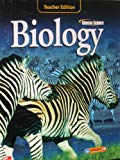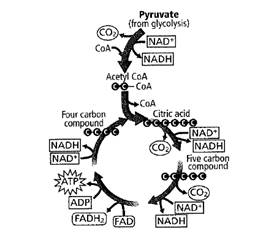
Concept explainers
To identify and summarize:
The steps of the cycle in the given figure
Introduction:
Organisms obtain energy through a process called
Answer to Problem 18STP
The cycle in the given figure is of Krebs cycle. The steps of the cycle can be summarized as follows:
- AcetylCoA combines with a 4- carbon compound to form a 6- carbon compound known as citric acid.
- Citric acid is then broken down in a series of steps releasing carbon dioxide and generates one ATP, 3 NADH and 1 FADH2.
- Finally acetyl CoA and citric acid are regenerated and the cycle continues.
Explanation of Solution
The following figure is given:

The end products of glycolysis are two ATP molecules and two pyruvate molecules. Most of the energy from the glucose is still present in pyruvate. In the presence of oxygen, pyruvate is transported into the mitochondrial matrix, where it is finally converted to carbon dioxide. The series of reactions involved in breaking down pyruvate to carbon dioxide is called Krebs cycle or tricarboxylic acid (TCA) cycle. It is also called citric acid cycle.
Just before Krebs cycle starts, pyruvate reacts with coenzyme CoA to form a two carbon intermediate called acetyl CoA. Carbondioxide is released and NAD+ is converted to NADH. AcetylCoA then moves to mitochondrial matrix. The reaction produces two CO2 molecules and two NADH.
The Krebs cycle starts with acetyl CoA combining with a 4- carbon compound to form a 6- carbon compound known as citric acid. Citric acid then breaks down in a series of steps releasing carbon dioxide and generating one ATP, 3 NADH and 1 FADH2. FAD and NAD+ are electron carriers.
Finally acetyl CoA and citric acid are regenerated and the cycle continues. Two turns of Krebs cycle occurs for one glucose molecule. The net yield of Krebs cycle is 6CO2 molecules, 2 ATP, 8NADH and 2FADH2.
Chapter 11 Solutions
Glencoe Science Biology, Teacher Edition, Hardcover Book Only
Additional Science Textbook Solutions
Campbell Biology in Focus (2nd Edition)
Concepts of Genetics (12th Edition)
Cosmic Perspective Fundamentals
Human Anatomy & Physiology (2nd Edition)
Human Physiology: An Integrated Approach (8th Edition)
Laboratory Experiments in Microbiology (12th Edition) (What's New in Microbiology)
- Based on your results from the Mannitol Salt Agar (MSA) media, which of your bacteria were mannitol fermenters and which were not mannitol fermenters?arrow_forwardhelp tutor pleasearrow_forwardQ8. A researcher wants to study the effectiveness of a pill intended to reduce stomach heartburn in pregnant women. The researcher chooses randomly 400 women to participate in this experiment for 9 months of their pregnancy period. They all need to have the same diet. The researcher designs two groups of 200 participants: One group take the real medication intended to reduce heartburn, while the other group take placebo medication. In this study what are: Independent variable: Dependent variable: Control variable: Experimental group: " Control group: If the participants do not know who is consuming the real pills and who is consuming the sugar pills. This study is It happens that 40% of the participants do not find the treatment helpful and drop out after 6 months. The researcher throws out the data from subjects that drop out. What type of bias is there in this study? If the company who makes the medication funds this research, what type of bias might exist in this research work?arrow_forward
- What is behavioral adaptarrow_forward22. Which of the following mutant proteins is expected to have a dominant negative effect when over- expressed in normal cells? a. mutant PI3-kinase that lacks the SH2 domain but retains the kinase function b. mutant Grb2 protein that cannot bind to RTK c. mutant RTK that lacks the extracellular domain d. mutant PDK that has the PH domain but lost the kinase function e. all of the abovearrow_forwardWhat is the label ?arrow_forward
- Can you described the image? Can you explain the question as well their answer and how to get to an answer to an problem like this?arrow_forwardglg 112 mid unit assignment Identifying melting processesarrow_forwardGive only the mode of inheritance consistent with all three pedigrees and only two reasons that support this, nothing more, (it shouldn't take too long)arrow_forward
 Human Anatomy & Physiology (11th Edition)BiologyISBN:9780134580999Author:Elaine N. Marieb, Katja N. HoehnPublisher:PEARSON
Human Anatomy & Physiology (11th Edition)BiologyISBN:9780134580999Author:Elaine N. Marieb, Katja N. HoehnPublisher:PEARSON Biology 2eBiologyISBN:9781947172517Author:Matthew Douglas, Jung Choi, Mary Ann ClarkPublisher:OpenStax
Biology 2eBiologyISBN:9781947172517Author:Matthew Douglas, Jung Choi, Mary Ann ClarkPublisher:OpenStax Anatomy & PhysiologyBiologyISBN:9781259398629Author:McKinley, Michael P., O'loughlin, Valerie Dean, Bidle, Theresa StouterPublisher:Mcgraw Hill Education,
Anatomy & PhysiologyBiologyISBN:9781259398629Author:McKinley, Michael P., O'loughlin, Valerie Dean, Bidle, Theresa StouterPublisher:Mcgraw Hill Education, Molecular Biology of the Cell (Sixth Edition)BiologyISBN:9780815344322Author:Bruce Alberts, Alexander D. Johnson, Julian Lewis, David Morgan, Martin Raff, Keith Roberts, Peter WalterPublisher:W. W. Norton & Company
Molecular Biology of the Cell (Sixth Edition)BiologyISBN:9780815344322Author:Bruce Alberts, Alexander D. Johnson, Julian Lewis, David Morgan, Martin Raff, Keith Roberts, Peter WalterPublisher:W. W. Norton & Company Laboratory Manual For Human Anatomy & PhysiologyBiologyISBN:9781260159363Author:Martin, Terry R., Prentice-craver, CynthiaPublisher:McGraw-Hill Publishing Co.
Laboratory Manual For Human Anatomy & PhysiologyBiologyISBN:9781260159363Author:Martin, Terry R., Prentice-craver, CynthiaPublisher:McGraw-Hill Publishing Co. Inquiry Into Life (16th Edition)BiologyISBN:9781260231700Author:Sylvia S. Mader, Michael WindelspechtPublisher:McGraw Hill Education
Inquiry Into Life (16th Edition)BiologyISBN:9781260231700Author:Sylvia S. Mader, Michael WindelspechtPublisher:McGraw Hill Education





